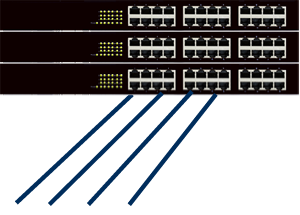1-Armed Direct Server Return (DSR) is used when the return traffic, from the load-balanced servers, can bypass the WebMux
This is also known as Direct Direct Routing or Out-of-Path (OOP)
1-Armed Direct Server Return (DSR) is used when the return traffic, from the load-balanced servers, can bypass the WebMux
This is also known as Direct Direct Routing or Out-of-Path (OOP)




The IPMI Port on the A500X, A500XD, and A600X models provides:
• Remote Power On and Power Off
• Remote console for troubleshooting
• IPMI data such as temp and fan speeds for data center operators who use IPMI

The MGMT port provides WebMux configuration LAN access. This separate port allows out-of-band management - separate from the LAN ports used for load-balancing functions.

The BACKUP port is used for High Availability (HA) failover communication for a pair of WebMux configuration

1-Armed DSR means that the clients come into the WebMux, get directed to a back-end server, and that server bypasses the WebMux on its response out to the client.
One connection or all four may be used, depending on the switch and its configuration options.
NETWORK TRAFFIC PORTS are, by default, configured as one aggregated link (LAG, "Etherchannel," etc.) to
provide maximum throughput.
IPMI, MGMT, BACKUP, and NETWORK TRAFFIC PORTS
Click each to toggle a description


Traffic returns to clients without going through the WebMux
Client traffic comes in, routed to the Farm/Virtual IP address, which load-balances between servers
1-Armed DSR requires a simple configuration "trick" on the back-end servers so that they will accept traffic from the WebMux: the servers need a loopback adapter configured with the IP address of the Farm. That will allow the NIC to process traffic for the Farm IP address as its own.